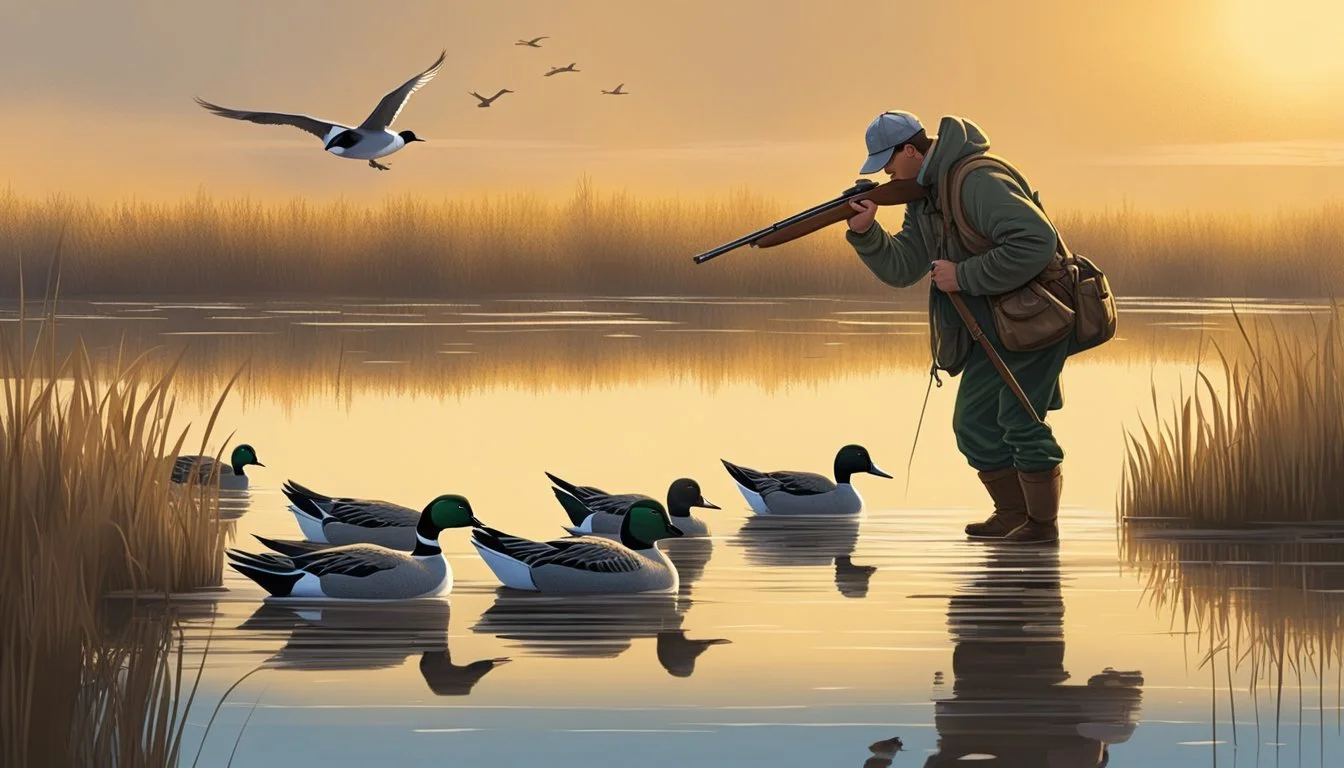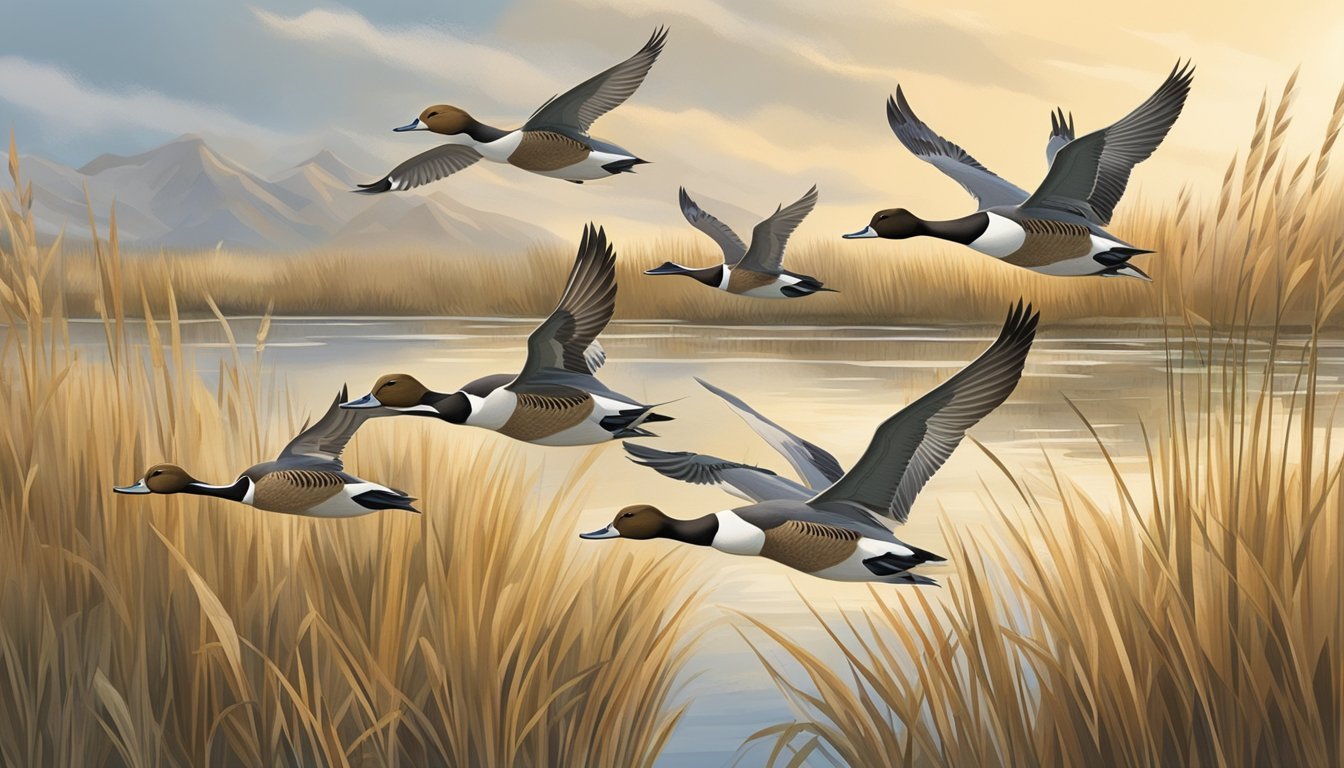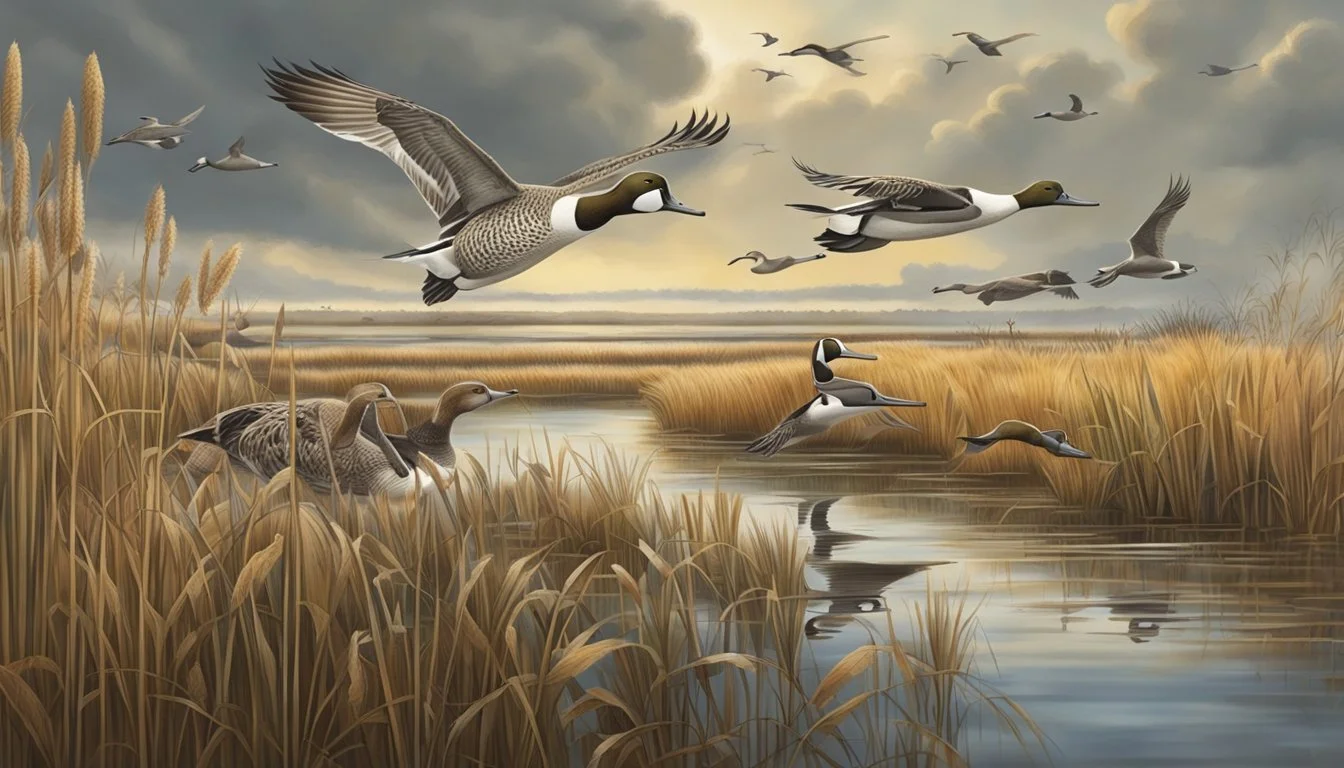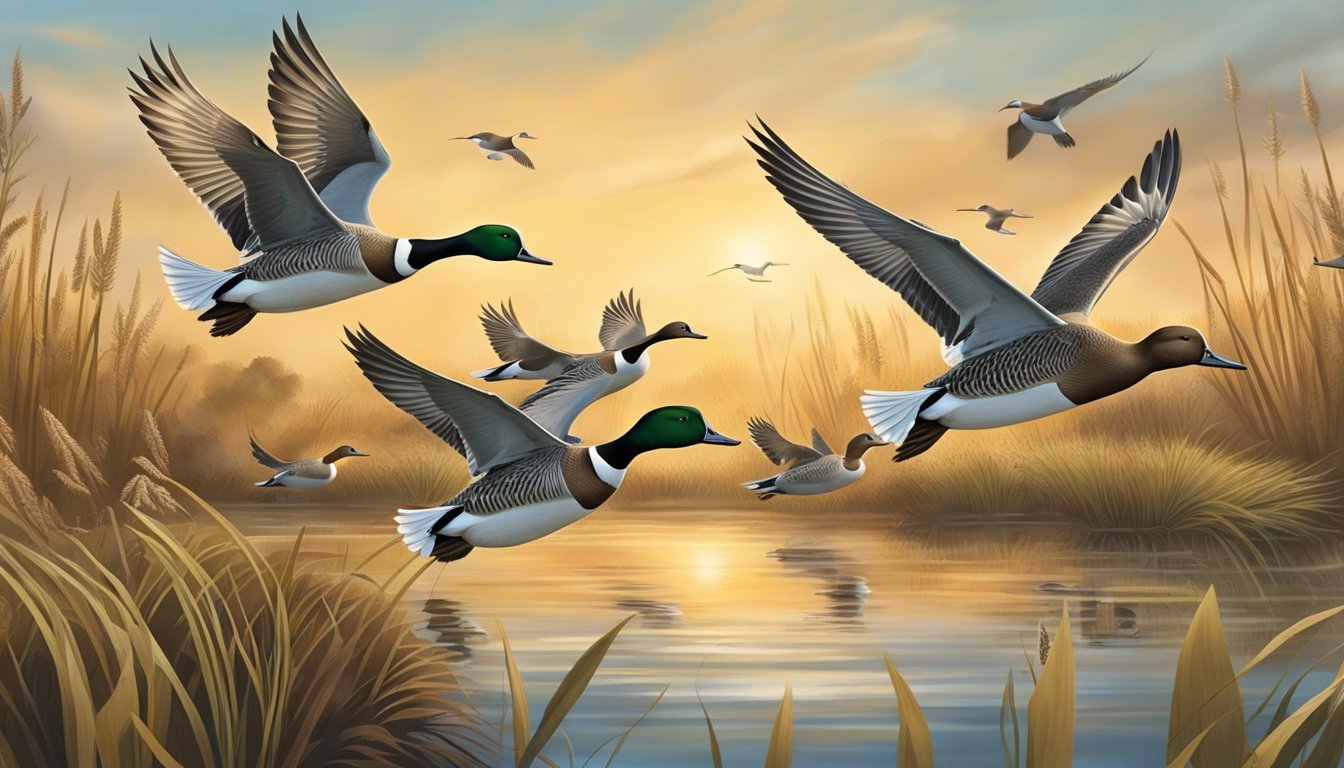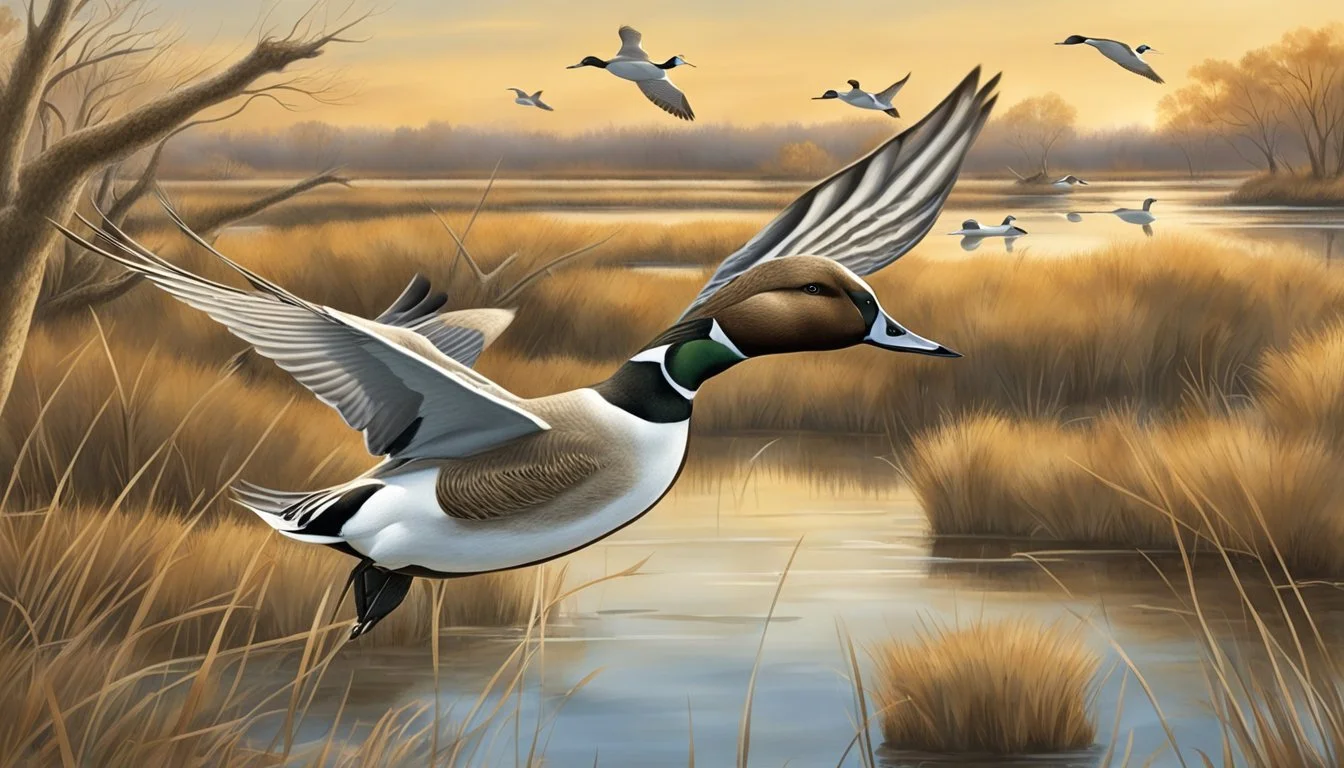Pintail Hunting Seasons
Optimal Times & Regional Regulations
This Article is Part of Our Guide on Hunting Seasons for Over 70 Common Game Species
Pintail ducks, (What wine goes well with duck?) with their distinguished long necks and sleek profiles, are among the most sought-after waterfowl species by hunters in North America. Known scientifically as Anas acuta, these elegant birds are often highlighted by their migratory patterns, which for hunters, underscores the importance of understanding the regulated hunting seasons to ensure sustainable populations. The hunting seasons for pintails are typically set within the broader framework of waterfowl hunting regulations, which are designed to balance the sport with conservation efforts.
These seasons are carefully determined by wildlife management agencies, taking into account migration timings, breeding periods, and population data to allow hunters the opportunity to pursue pintails without adversely affecting their numbers. As migratory birds, pintails traverse vast distances across the continent, and their presence in specific regions is both awaited by enthusiasts and monitored by conservationists. Hunters looking to participate in pintail hunting must adhere to established seasons, which can vary by state or zone, such as those outlined by the California Department of Fish and Wildlife for specific regions within the state.
Such regulations ensure that hunting aligns with the overarching goals of wildlife preservation and ecosystem balance. This collaborative approach between hunters, conservationists, and policymakers fosters an environment where the tradition of hunting is respected alongside the imperative of maintaining healthy pintail populations for future generations. Through licensed and regulated hunting within set seasons, hunters play a vital role in the sustainable management of pintail ducks and contribute to the ongoing efforts to conserve North America's rich biodiversity.
Pintail Species Overview
The Northern Pintail (Anas acuta), distinctive for its elegance, occupies various habitats across the globe. This section provides a snapshot of their physical characteristics, habitats, breeding, nesting habits, and migration patterns.
Physical Characteristics
The Northern Pintail, a type of dabbling duck, exhibits sexual dimorphism. Drakes (males) have a chocolate-brown head and a white stripe that runs down their neck. Their body is gray, with a black central tail feather giving the species its pointed appearance. Hens (females) have a more subdued palette with mottled brown feathers, which help camouflage them. Both sexes feature a distinctive white underbelly and green speculum bordered by white. The species is renowned for their long necks and tails.
Habitat and Distribution
Pintails thrive in various environments, preferring open areas near water. They can be found in wetlands, grasslands, tundra regions, and alongside lakes and ponds. Their breeding territory mainly includes the prairie pothole region of the Great Plains in North America, extending to central Canada and Alaska.
Breeding and Nesting Habits
During the breeding season, Northern Pintails nest on the ground, often hidden in grassy areas. The hen is responsible for constructing the nest, which she lines with down plucked from her own breast. Clutch size varies, but typically includes 7-10 eggs, which the hen incubates for about 21-25 days.
Migration Patterns
Pintails are known for their long migratory journeys. They breed in the northern regions and travel to wintering grounds in the southern United States, Mexico, and even as far south as Central America. These ducks exhibit remarkable navigation skills, following well-established flyways to reach their destinations.
Regulatory Framework
In managing pintail hunting seasons, a regulatory framework is established to ensure the sustainability of bird populations while providing opportunities for hunting. This framework is shaped by legal statutes and is implemented by wildlife agencies, which determine season specifics such as dates and limits.
Legal Protections and Restrictions
Migratory birds, including pintails, are protected under the Migratory Bird Treaty Act (MBTA) and other relevant laws. These legal protections dictate that hunting regulations must be enforced to safeguard bird populations. U.S. Fish and Wildlife Service (FWS) is tasked with establishing regulations within this legal framework, including the determination of safe harvest levels and the prohibition of certain practices.
Role of Wildlife Agencies
The FWS, working alongside state agencies, plays a critical role in tailoring the hunting regulations. They assess population dynamics and other ecological data to set annual hunting seasons. The Service Regulations Committee reviews and forwards its decisions on annual migratory bird hunting regulations to higher authorities within the Department of the Interior for final approval.
Season Dates and Shooting Hours
Specific season dates and shooting hours are established within the final frameworks provided by the FWS. For instance, the frameworks for the 2022-23 hunting season set the permissible periods during which hunters can hunt migratory game birds. States may then select their respective season dates, typically aligning with the migratory patterns of the birds.
Bag and Possession Limits
Hunters must adhere to strict daily bag and possession limits, which are part of the established framework. These limits are assessed annually and can vary by species and geographic region. For the pintail, any changes to the bag limits, such as increases or decreases, are based on the most current data and can influence the structure of the following hunting season.
Regulatory strategies may be optimized annually. For instance, an optimal regulatory strategy for the pintail is assessed and noted in FWS documentation, considering factors like hunter satisfaction and pintail abundance to determine bag limits for upcoming seasons.
Hunting Techniques and Strategies
In the pursuit of the Northern Pintail, hunters must combine effective decoy spreads and calls with an understanding of the bird’s preferred habitats and behaviors. This section outlines strategic approaches to increase hunting success for this revered waterfowl species.
Decoys and Calls
Decoys play a pivotal role in luring pintails into range. A mix of pintail decoys with other dabbling ducks such as mallards helps create a natural-looking setup. Hunters should arrange decoys in a loose group that mimics a feeding flock, with a pocket left open to encourage pintails to land. Calls, albeit used sparingly since pintails are not as vocal as other ducks, can include soft whistles meant to emulate the sound of a flock.
Hunting Locations and Terrain
Pintails prefer open waters and are often found in regions like California and Alaska during migration seasons. In California, the birds frequent the Central Valley, where hunters should scout for flooded agricultural fields and marshes. In Alaska, expansive wetlands provide prime hunting grounds during the spring and fall migrations.
Weather and Timing Considerations
Weather plays a crucial role in the behavior of pintails; they are more active on windy and cloudy days, making these conditions ideal for hunting. Hunters need to pay attention to migration patterns, which typically peak in fall in the lower 48 states, to ensure they're in the field at the opportune times.
Shot Selection and Ethics
Being proficient with a shotgun is critical, but ethical shot selection is paramount. Hunters should aim for clean shots within 30 yards to ensure a humane harvest. Use of non-toxic shot is mandatory, and education on waterfowl identification is imperative to respect bag limits and species conservation.
Conservation and Population Management
The stability of Northern Pintail populations is closely linked to effective conservation and management practices, which seek to address the challenges of population decline and habitat loss.
Impact of Hunting on Populations
The Northern Pintail is a waterfowl species subject to hunting regulations due to fluctuations in its breeding population. Recent data indicates a breeding population just above 1.78 million birds, perilously close to the 1.75 million threshold which could necessitate a moratorium on hunting. Regulatory agencies monitor these numbers annually to ensure hunting does not negatively impact the overall population stability.
Conservation Programs and Efforts
Conservation programs have become critical in managing Northern Pintail numbers. Investments in these programs are focused on the species' primary breeding grounds, such as the Prairie Pothole Region, although these efforts currently impact less than 2% of the area. The goal is to increase this percentage to sustain a viable breeding population, as part of the North American Waterfowl Management Plan aiming for 5.5 million birds.
Habitat Restoration Initiatives
Habitat restoration is pivotal for Pintail conservation. Conservationists promote agricultural practices that enhance waterfowl habitats and collaborate with farmers to allocate land that supports waterfowl breeding. Projects focusing on grassland restoration and the protection of wetlands are vital, as these are preferred breeding and feeding grounds for pintails.
Research and Monitoring
Ongoing research and monitoring are guiding conservation strategies. A significant investment of $1.6 million has been made toward a project designed to inform further management of the Northern Pintail. This involves tracking bird movements and habitat usage to gain insights, which in turn informs habitat restoration and other conservation initiatives. Data from annual Waterfowl Breeding Population and Habitat Surveys is crucial for adjusting conservation efforts in line with current population trends.
Pintail Hunting Culture and Heritage
Pintail hunting has a storied tradition deeply rooted in history and continues to have a significant social and economic impact. Proper education and adherence to ethical hunting practices are fundamental to this outdoor activity.
Historical Perspectives
The Northern Pintail is a revered species among game birds, with hunting practices dating back generations. Hunters have long celebrated the species for its elegance and the unique challenge it presents due to its fast, erratic flight patterns. Historically, the prowess of a hunter was often measured by their skill in bagging this elusive duck.
Social and Economic Impact
Duck hunting, especially of Northern Pintails, not only serves as a social bonding experience but also contributes substantially to local economies. Licenses, equipment sales, and tourism associated with hunting activities help support businesses and conservation efforts. The sport is often a family tradition, passed down and sustaining the cultural fabric of many communities where duck hunting is prevalent.
Education and Ethical Hunting
Emphasis on education in pintail hunting is crucial, ranging from species knowledge to conservation laws. Ethical hunting practices are taught to ensure the sustainability of Northern Pintail populations. Hunters learn about bag limits, set by U.S. Fish and Wildlife Service based on population size, ensuring that the harvest does not negatively impact the species' survival.
By understanding the importance of these factors, hunters contribute to the careful management of game bird populations, thus balancing tradition with conservation.
Environmental and Ecological Considerations
Environmental and ecological elements play a crucial role in shaping pintail hunting seasons. These factors influence pintail populations, their behaviors, and ultimately their conservation.
Effects of Climate Change
Climate change impacts northern pintail habitats significantly. Droughts exacerbated by a warming climate lead to the loss of wetlands, affecting the availability of grasses and seeds which are essential to pintail diets. These environmental shifts challenge pintails' ability to adapt and may alter migratory patterns.
Interactions with Other Wildlife
Northern pintails coexist with various wildlife species, especially in wetland ecosystems. Ecological imbalances, such as those caused by invasive species, can disrupt food chains and compete for resources, affecting pintail survival and breeding success.
Food Sources and Foraging Behavior
Pintails primarily feed on a variety of plants, seeds, and crustaceans.
In Agricultural Areas:
Rice fields provide critical foraging grounds, especially in winter.
Flooded rice fields specifically offer an alternative habitat similar to natural wetlands.
Natural Habitats:
They also forage on natural wetlands where grasses and seeds are abundant.
Their foraging behavior is closely tied to the availability of these food sources, which are influenced by both natural conditions and agricultural practices.
Impact of Human Activities
Human activities, including agricultural practices and hunting, directly influence pintails and their habitats.
Agriculture:
Conversion of natural wetlands to cropland for wheat, corn, and rice affects food availability.
Sustainable practices, such as maintaining flooded fields post-harvest, can provide supportive habitats for pintails.
Hunting:
Regulated hunting is structured to minimize negative impacts on pintail populations, with seasons and limits informed by ongoing research and monitoring.
Identification and Field Guide
When hunting for pintails, it’s crucial to identify them accurately to ensure compliance with hunting regulations and to maintain ethical hunting practices.
Distinguishing Pintails from Similar Species
The Northern Pintail (Anas acuta) stands out with its slender, elegant profile. Males are characterized by a distinctive white breast, chocolate brown head, and a white stripe running up the neck. Females are more subtle with mottled brown plumage. In comparison to Mallards, pintails have a more streamlined appearance, and lack the vibrant green head and white ring around the neck that male Mallards display. The bill of a pintail is gray-blue, distinctively different from Mallards whose bills are yellowish-green. Pintails also lack the noticeable speculum - the colorful wing patch - that is present in Mallards, teal, and Wood Ducks.
Trait Northern Pintail Mallard Teal Wood Duck Bill Color Gray-blue Yellowish-green Variable Brightly patterned Body Shape Slender, elongated Stocky, rounded Compact Sleek, crested Speculum Absent Iridescent blue-purple Iridescent, colored Iridescent, bordered by white
Sexual Dimorphism in Pintails
Pintails exhibit sexual dimorphism, which means males and females have different physical appearances. Male pintails display a long, pointed tail, hence the name, and during the breeding season, possess a bold white stripe that extends from the throat down the neck, contrasting with their dark heads. Female pintails, on the other hand, have a more uniform brown color and a shorter tail, providing excellent camouflage while nesting.
Sex Plumage Tail Notable Features Male White breast, brown head Long, pointed White stripe on neck Female Mottled brown Shorter, rounded Camouflaged for nesting
Juvenile and Adult Plumage
Juvenile pintails resemble adult females in coloration and mark a transition into adult plumage as they mature. Juvenile males can be distinguished by their gradually emerging adult features by their first winter. They start to acquire the classic male plumage, with the elongated central tail feathers becoming more pronounced. Unlike some duck species where plumage changes can be abrupt, pintails change more smoothly over time.
Juvenile Male: Begins to show white breast and neck stripe in first winter.
Juvenile Female: Similar to adult females, more uniform brown plumage throughout.
Additional Regulations and Considerations
When planning for pintail hunting seasons, hunters must navigate a complex framework of regulations designed to balance conservation efforts with the tradition of hunting. Compliance with these rules is essential for the protection of migratory game birds and the sustainability of the sport.
Migratory Bird Treaty Act Compliance
The Migratory Bird Treaty Act (MBTA) mandates protection for various species, including but not limited to pintails, doves, woodcock, coots, mergansers, and certain types of geese such as brant, white-fronted geese, and light geese. Hunters must adhere to the following regulations:
Bag Limits: Strictly enforced limits on the number of birds a hunter can harvest per day.
Season Length: The hunting season's start and end dates are regulated to coincide with migratory patterns.
Permits: Hunters require appropriate state and federal permits to hunt migratory game birds.
International Hunting Laws
International considerations play a crucial role in the management of migratory bird populations. Hunters should be aware of the following:
Bilateral Treaties: The United States has agreements with Canada and Mexico to align hunting regulations, considering these birds do not adhere to national borders.
Population Monitoring: Harvest strategies are based on international surveys and data, which inform annual regulations.
Falconry and Extended Seasons
Falconry, the practice of using trained raptors for hunting, has its specific regulations which can include extended seasons for certain species:
Extended Seasons: Some migratory game birds may have extended falconry seasons beyond the general hunting dates.
Special Limits: Falconers may have different bag and possession limits. It is crucial to consult state regulations for precise information.

